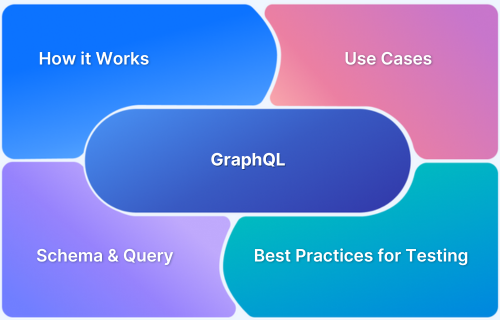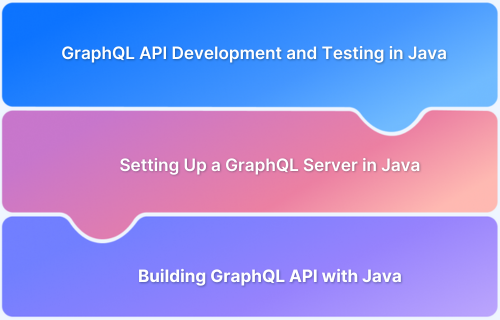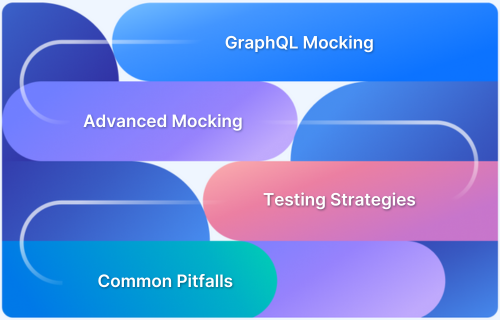GraphQL lets applications request exactly the data they need, reducing network calls and payload size. Using it effectively can improve API performance, simplify frontend development, and accelerate feature delivery.
Overview
What Is GraphQL?
GraphQL is a query language for APIs that lets clients specify the structure of the data they need. Unlike REST, which requires multiple endpoints for different data shapes, GraphQL provides a single, flexible endpoint that adapts to varying client requirements.
Advantages of Using GraphQL
- Exact Data Fetching: Clients request only the fields they need, reducing over-fetching and improving performance.
- Unified Endpoint: Combines multiple resources into a single API, simplifying client-server interaction.
- Self-Describing Schema: Enables clear contracts between client and server, reducing runtime errors.
- Easier API Evolution: Adds new fields without breaking existing queries, avoiding multiple API versions.
- Improved Frontend Agility: Supports rapid frontend changes without backend modifications.
Key Use Cases of GraphQL
- Complex UIs: Applications needing data from multiple sources in a single request.
- Mobile or Low-Bandwidth Clients: Reduces payload size and network overhead.
- Rapid Product Iteration: Frontend teams can adjust queries without backend changes.
- Microservices Aggregation: Acts as a single access point to multiple backend services.
- Dynamic Dashboards or Analytics: Clients can fetch varying fields without backend updates.
When to Consider an Alternative to GraphQL
- Simple Data Models: If the API mostly handles straightforward CRUD operations with minimal relationships, REST is easier to implement and maintain.
- Extensive Caching Needs: When responses need aggressive caching, REST and HTTP caching strategies are simpler and more reliable than GraphQL’s dynamic queries.
- Large File Handling: Uploading or streaming large files is cumbersome in GraphQL, whereas traditional endpoints handle binary data more efficiently.
- Low-Latency or Lightweight APIs: For very simple or performance-sensitive APIs, the overhead of parsing GraphQL queries may be unnecessary.
- Team Experience Constraints: Teams without prior GraphQL experience may face steep learning curves, slowing down development and introducing bugs.
This article explains when GraphQL is the right choice, when it is not, and how to design APIs that balance performance, flexibility, and maintainability.
What Is GraphQL?
GraphQL is a query language and runtime for APIs that lets clients specify exactly what data they need. Unlike REST APIs, which often require multiple endpoints for different data shapes, GraphQL exposes a single endpoint that adapts to varying client requirements.
GraphQL uses a strong type system to define the structure of data, enabling precise queries, clear contracts between client and server, and predictable responses.
Why Use GraphQL?
GraphQL addresses common problems in modern applications where data needs are complex, changing, or coming from multiple sources.
Below are key advantages of using GraphQL:
- Precise Data Fetching: Clients receive only the fields they request to reduce over-fetching and lower bandwidth use and improve app performance.
- Single Access Point: Combines multiple backend resources into one endpoint to simplify frontend queries and integration.
- Flexible Schema Evolution: Add new fields without breaking existing queries to avoid versioning issues or deployment delays.
- Strong Typing and Introspection: Define schemas to enable tooling, generate documentation, and detect mismatched queries or errors early.
- Accelerated Frontend Changes: Modify queries independently of backend changes to reduce coordination delays and speed up development.
When to Use GraphQL
GraphQL is most effective when data needs are complex, change frequently, or come from multiple sources. Using it in the right scenarios reduces development friction, avoids performance issues, and improves client flexibility.
Consider GraphQL in these situations:
- Complex Frontend Requirements: When a view needs data from multiple endpoints, GraphQL reduces the number of network requests and prevents under-fetching or over-fetching. This lowers latency and simplifies state management in frontend applications.
- Mobile or Low-Bandwidth Clients: Mobile devices or clients with limited bandwidth benefit from requesting only the necessary fields, which reduces payload size and improves responsiveness.
- Rapid Feature Iteration: Teams can introduce new features or modify frontend views without backend changes by adjusting queries directly. This accelerates development cycles and reduces coordination overhead.
- Microservices Aggregation: GraphQL acts as a unified layer over multiple microservices, allowing clients to fetch combined data with a single request instead of managing multiple REST calls. This improves consistency and reduces boilerplate in client code.
- Dynamic Dashboards or Analytics: Applications with varying metrics or dashboard configurations can request different fields or nested relationships on demand. This flexibility avoids backend refactoring and supports evolving business requirements.
When Not to Use GraphQL
GraphQL adds flexibility but also complexity. Choosing it in the wrong scenarios can slow development, increase maintenance overhead, or reduce performance.
Consider alternatives in these cases:
- Simple APIs: For APIs with straightforward CRUD operations or flat data structures, REST or traditional endpoints are easier to implement, maintain, and debug.
Also Read: Best REST API Client Tools for 2025
- Heavy Caching Needs: When responses require aggressive caching at the HTTP level, REST is more predictable and easier to optimize. GraphQL’s dynamic queries complicate caching strategies.
- Large File Transfers or Streaming: Uploading or streaming binary data is cumbersome in GraphQL. Traditional API endpoints handle large files and continuous streams more efficiently.
- Performance-Sensitive, Lightweight APIs: GraphQL query parsing adds overhead. For lightweight requests or latency-critical endpoints, simpler APIs perform better.
- Teams with Limited GraphQL Experience: Adopting GraphQL requires learning schema design, query structure, and tooling. Teams unfamiliar with it may face slower development, more bugs, and higher maintenance effort.
GraphQL vs REST: Hybrid Approaches and Tradeoffs
GraphQL and REST offer different strengths for API design. GraphQL handles complex, related data in one request and lets clients request only what they need. REST is simple, predictable, and easier to cache or monitor. Teams often combine the two to use each approach where it fits best.
Below is a table highlighting the key differences and tradeoffs between GraphQL and REST:
| Aspect | GraphQL | REST | Tradeoff / Hybrid Use |
| Data Fetching | Request only required fields in one query | Return predefined data from fixed endpoints | Use GraphQL for complex views and REST for simple endpoints |
| Endpoint Structure | Single flexible endpoint | Multiple resource-specific endpoints | Combine GraphQL for dynamic clients and REST for backend simplicity |
| Caching | Requires custom caching logic | Use standard HTTP caching | Use REST for cache-heavy endpoints and GraphQL for dynamic queries |
| Frontend Flexibility | Frontend defines data shape | Backend defines response structure | Use GraphQL to support rapid UI changes and REST for stable responses |
| Performance | Reduces network calls but adds parsing overhead | Lightweight and fast for simple calls | Use GraphQL to reduce requests and REST to keep simple endpoints fast |
| Tooling | Schema introspection and auto-documentation | Mature logging and monitoring tools | Leverage GraphQL for development efficiency and REST for production stability |
How to Migrate from REST to GraphQL
Migrating from REST to GraphQL requires careful planning to avoid breaking existing functionality and to maximize the benefits of flexible queries. Teams should follow structured steps to ensure a smooth transition and maintain application stability.
Below is a step-by-step guide to migrate from REST to GraphQL.
Step 1: Analyze Existing Endpoints
Review all REST endpoints and map the data they provide. Identify overlaps, repeated calls, and endpoints that are frequently used together. This analysis helps design efficient GraphQL queries and avoids unnecessary complexity.
Step 2: Define the GraphQL Schema
Create types and relationships that reflect the data needs of clients. Include queries, mutations, and any necessary input types. Focus on modeling the data as clients will consume it rather than mirroring REST endpoints exactly.
Step 3: Implement Resolver Functions
Write resolvers to fetch data from existing REST endpoints, databases, or microservices. Start with read operations and gradually add mutations. Ensure resolvers are optimized to prevent the N+1 query problem.
Step 4: Incremental Migration
Introduce GraphQL alongside REST rather than replacing it immediately. Route some client requests to GraphQL and monitor performance and stability. This allows teams to iterate and fix issues without disrupting existing applications.
Step 5: Deprecate REST Endpoints Gradually
Once GraphQL is stable and widely adopted by clients, gradually retire overlapping REST endpoints. Communicate changes to dependent teams and update documentation to avoid disruption.
Step 6: Testing and Validation
Test GraphQL queries against different client scenarios to ensure data correctness and performance. Validate that queries return only requested fields and handle errors consistently. Tools like Requestly can help simulate and inspect requests in real time, making it easier to catch inconsistencies, test edge cases, and verify responses before fully migrating clients.
GraphQL Best Practices for Successful Implementation
Implementing GraphQL without careful design can lead to performance issues, confusing queries, or security risks. Teams should focus on schema design, query control, caching, and access management to avoid these problems.
Below are practical best practices to guide implementation:
- Design a Clear Schema: Structure types and relationships to match client consumption rather than mirroring backend tables. A well-planned schema reduces complexity and simplifies queries.
- Use Query Depth and Complexity Limits: Prevent overly complex or deeply nested queries by enforcing depth limits and query cost analysis. This protects servers from performance degradation.
- Batch and Cache Data in Resolvers: Combine related requests and cache frequently used data to reduce repeated calls to databases or microservices and improve response times.
- Implement Strong Validation and Error Handling: Validate input types, enforce required fields, and return clear errors. This ensures predictable behavior and easier debugging.
- Version Gradually via Deprecation: Avoid breaking changes by deprecating old fields instead of removing them immediately. Communicate changes to clients to maintain stability.
- Monitor and Log Queries: Track query usage, performance, and errors to identify hotspots and optimize frequently used queries. Logging also helps detect abuse or inefficient patterns.
- Secure Access with Authentication and Authorization: Use role-based access controls to restrict sensitive data and enforce permissions at the schema or resolver level.
How Requestly Helps Test GraphQL APIs
Requestly is a browser-based tool that allows developers to manage and test API requests directly without changing backend code.
Requestly enables developers to intercept and modify GraphQL APIs and mock responses directly from the browser to support frontend development and testing without backend dependencies.
Below are some core features of Requestly that help teams test GraphQL APIs effectively:
- Intercept and Modify Requests: Alter GraphQL queries or variables in real-time to test different user roles, pagination scenarios, or error handling.
- Mock Responses: Define custom responses for specific GraphQL operations to verify frontend behavior when backend services are unavailable.
- Redirect API Calls: Reroute GraphQL requests to mock servers or alternative environments to simulate staging or production conditions.
- Target Requests Dynamically: Select GraphQL requests based on operation names or query content to apply changes only where needed.
- Client-Side Testing: Perform all modifications in the browser to test and debug without touching backend code.
Conclusion
GraphQL allows precise data fetching and flexible queries, making it ideal for complex applications, mobile clients, and rapidly changing frontend requirements. It reduces over-fetching, simplifies access to multiple backend services, and supports dynamic dashboards and microservices aggregation.
Requestly helps developers test GraphQL APIs by intercepting, modifying, and mocking requests directly in the browser. Developers can simulate different scenarios, validate frontend behavior, and debug without changing backend code to ensure reliable API integration and faster development cycles.







